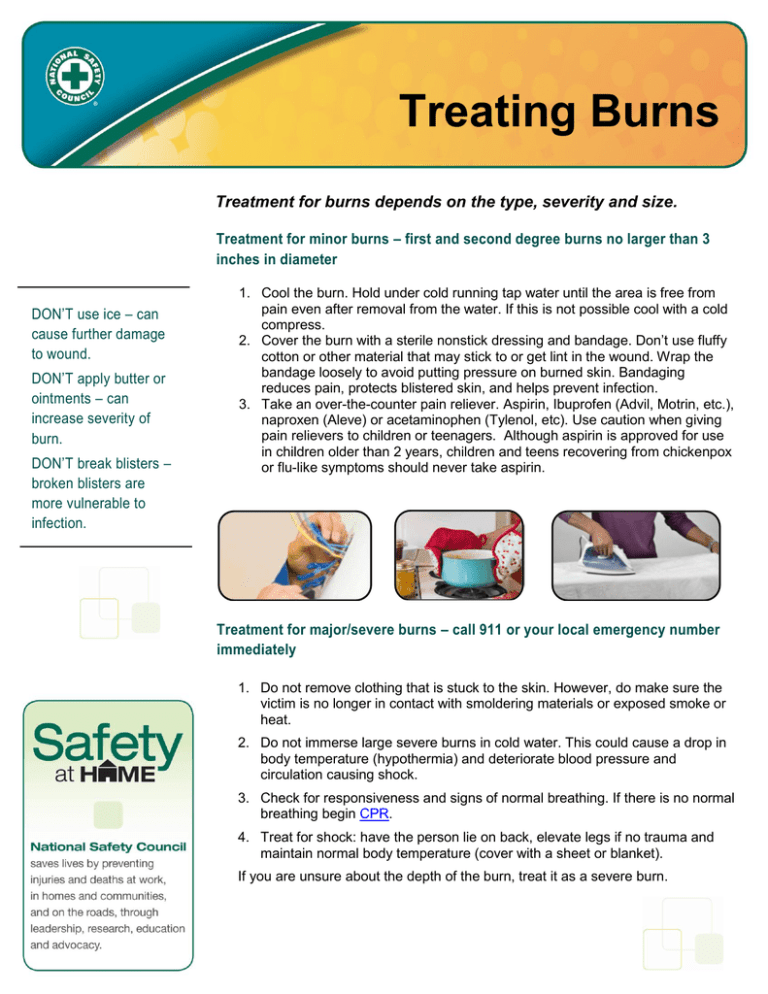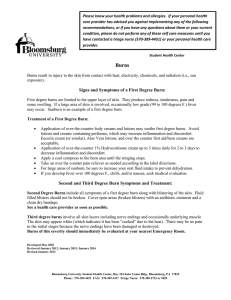Treatment for burns depends on the type, severity
advertisement

Treating Burns Treatment for burns depends on the type, severity and size. Treatment for minor burns – first and second degree burns no larger than 3 inches in diameter DON’T use ice – can cause further damage to wound. DON’T apply butter or ointments – can increase severity of burn. DON’T break blisters – broken blisters are more vulnerable to infection. 1. Cool the burn. Hold under cold running tap water until the area is free from pain even after removal from the water. If this is not possible cool with a cold compress. 2. Cover the burn with a sterile nonstick dressing and bandage. Don’t use fluffy cotton or other material that may stick to or get lint in the wound. Wrap the bandage loosely to avoid putting pressure on burned skin. Bandaging reduces pain, protects blistered skin, and helps prevent infection. 3. Take an over-the-counter pain reliever. Aspirin, Ibuprofen (Advil, Motrin, etc.), naproxen (Aleve) or acetaminophen (Tylenol, etc). Use caution when giving pain relievers to children or teenagers. Although aspirin is approved for use in children older than 2 years, children and teens recovering from chickenpox or flu-like symptoms should never take aspirin. Treatment for major/severe burns – call 911 or your local emergency number immediately 1. Do not remove clothing that is stuck to the skin. However, do make sure the victim is no longer in contact with smoldering materials or exposed smoke or heat. 2. Do not immerse large severe burns in cold water. This could cause a drop in body temperature (hypothermia) and deteriorate blood pressure and circulation causing shock. 3. Check for responsiveness and signs of normal breathing. If there is no normal breathing begin CPR. 4. Treat for shock: have the person lie on back, elevate legs if no trauma and maintain normal body temperature (cover with a sheet or blanket). If you are unsure about the depth of the burn, treat it as a severe burn. Treatment for electrical burns Victims of electrical burns should always seek medical care. While waiting for medical care: The United States National Poison Hotline is 1-800-222-1222. You will be automatically linked to your closest poison control center. 1. Look first. Don’t touch. A person may still be in contact with an electrical source. If you touch them, the current can pass through you, causing you shock. 2. Unplug or turn off the source of electricity, if possible. If this is not possible, not touch the victim. Call 911. 3. Check for responsiveness and normal breathing. If there is no normal breathing, being CPR (cardiopulmonary resuscitation) immediately. 4. If responsive and breathing, treat for shock. Lay the person down and elevate the legs, if there is no trauma. Maintain normal body temperature. 5. Cover the affected areas. If the person is breathing, cover any burned areas with a sterile cause (nonstick preferred) or a clean cloth. Don’t use a blanket or towel. The loose fibers can stick to the burns. Treatment for chemical burns 1. Identify the chemical that was involved. As work, have someone check the material safety data sheet (MSDS) for this information. 2. Move the victim away from fumes or ventilate the area. 3. With a gloved hand or piece of cloth, brush off any dry chemical. 4. Remove clothing and jewelry from the burn area. 5. Flush the entire area as quickly as possible with large amounts of running water. Flush until EMS personnel arrive to give definitive care or until a topic specific solution is available. 6. Contact the Poison Control Center in your area or 911. Many chemical burns may be treated with local wound care. Some chemicals can cause life- and limb-threatening injuries and need emergency care. 7. Victims with chemical burns to their eyes should always seek emergency care. Flush the victim’s eye with large amount of running water until EMS arrives. Have a victim wearing contact lenses remove them. Treatment for sunburns 1. Take a cold shower or bath, or place cool cloths on your burn 2. Avoid using creams that contain benzocaine, lidocaine and petroleum (Vaseline) 3. If you have blisters, dry bandages can help prevent infection 4. If you do not have blisters, use aloe vera to relieve some of the discomfort. 5. Adults can use medications like ibuprofen to relive some of the pain from the burn. DO NOT give children aspirin.


